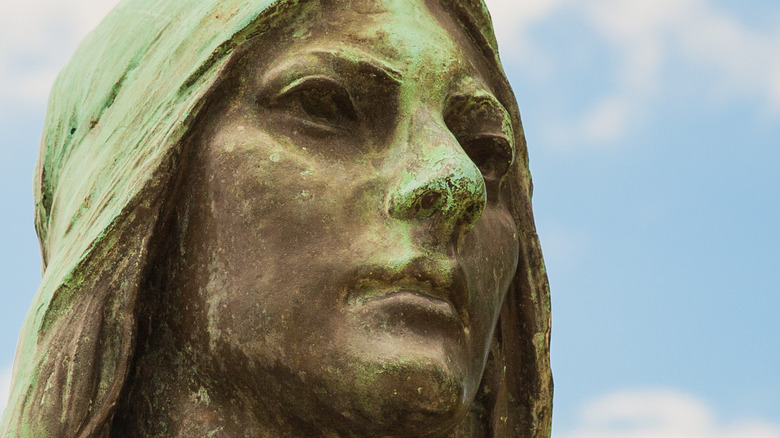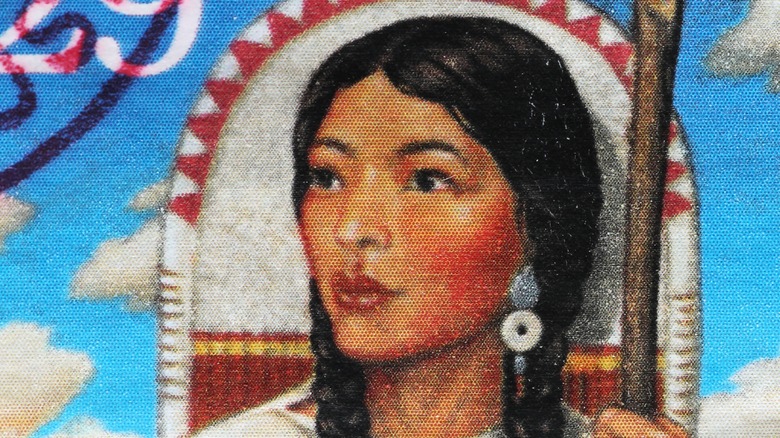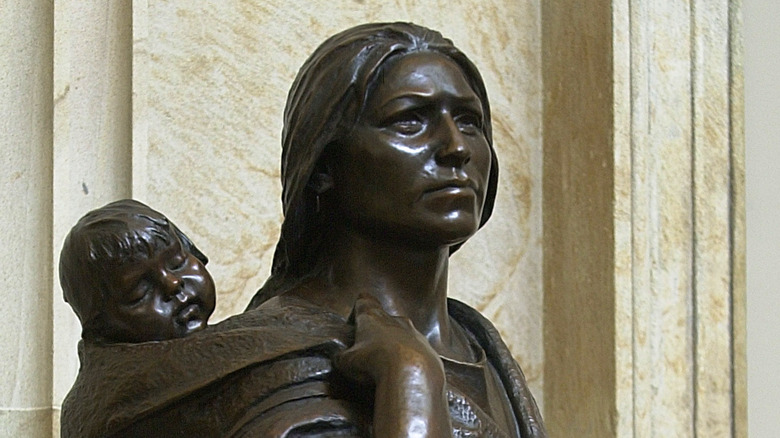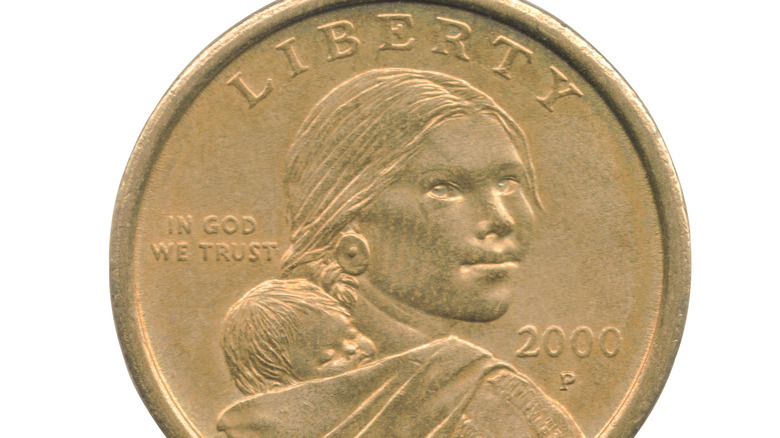The Biggest Theories About The Meaning Of Sacagawea's Name
Sacagawea is one of those figures most of us learned about on our first pass through elementary school. Like John Henry or Benjamin Franklin, her life is used to exemplify the best of what it means to be an American. And like others who have passed from the pages of history into the popular imagination, something of their authentic selves and stories has been lost.
Almost all of our knowledge about the historical Sacagawea comes from the journals of the explorers on the Lewis and Clark expedition. In those narratives she's little more than a side character in the whole tale of the journey, whereas in the popular mythology that's sprung up around her, she's an indispensable guide and the linchpin to the entire undertaking (via Hohonu).
The teenage bride of a middle-aged Frenchman, she and her spouse were brought along for their knowledge of native languages. But she only spoke Shoshone and Hidatsa; her husband spoke Hidatsa and French; and one member of the expedition spoke French and English. It's from this cumbersome chain of translations that we received all of our knowledge about Sacagawea. It's little wonder then that we don't know for sure what her name was or what it meant.
Sacajawea
This form of the name first appeared in the decade following the expedition in an 1814 publication that attempted to standardize the many spellings of her name in the journals of Lewis and Clark (via Washington State History Museum). This spelling was popularized nearly a century later when the author Eva Emery Dye co-opted the story of Sacagawea and recast her as a feminist icon to popularize the then-radical idea of women's suffrage (via Sacagawea Historical Society and BuzzFeed News).
The modern Lemhi Shoshone tribe, to which Sacagawea was born, use this spelling. Proponents of this orthography contend that "Sacajawea" is a compound of the Shoshone words for "boat," "to pull," and "to go" (via The Legend of Her Name). Even though the spelling remains popular in Idaho, where Sacagawea was born, academics generally reject the idea that "Sacajawea" is a Shoshone name. Despite that, this is the most popular pronunciation of her name, irrespective of orthography.
Sakakawea
Sacagawea was born a Shoshone, but around the age of 12 she was abducted by a band of Hidatsa and brought from what is now Idaho to present-day North Dakota (neither of which existed yet). We know from the journals of Lewis and Clark that her name meant "Bird Woman" in the Hidatsa language, and in a Hidatsa dictionary from the 19th century are the words "tsa-ka-ka" for bird, and "mia" for woman (which becomes "wia" if it follows a vowel). From this, the name "Sakakawea" can be derived (via Washington State History Museum).
Proponents of this orthography are the Hidatsa tribe and all of North Dakota. In 2003 the state gifted a sculpture of Sacagawea to the National Statuary Hall Collection called "Sakakawea," and there are numerous landmarks in the state that bear the name.
The biggest problem with this spelling comes from the journals of Lewis and Clark. Throughout the record of their journey, Sacagawea's name is spelled more than a dozen different ways — both leaders of the expedition were notoriously poor and inconsistent spellers. But the one thing all those spellings have in common is that all have a hard "g" sound where other spellings have a "j" or a "k" sound.
Sacagawea
The spelling favored by the U.S. government and the National Park Service is "Sacagawea." In addition to the numerous journal entries attesting to pronouncing middle syllable with a hard "g" sound, the 19th century dictionary from which "Sakakawea" is derived explicitly points out that the "k" sound is often changed to a "g" sound, making "Sacagawea" faithful to both first-hand accounts and linguistic records (via Washington State History Museum).
After her journey with Lewis and Clark, Sacagawea returned to North Dakota with her husband. William Clark was very taken with the family, and in particular their first child, Jean Baptiste. Clark invited them to St. Louis so he could help to raise and educate the youngest member of the expedition. The family eventually accepted the invitation but returned to North Dakota a few years later, where Sacagawea had a daughter and died shortly after, age 25.
Despite the obscurity of the details of her life, Sacagawea is one of the most honored women in American history. There are more statues of her in the U.S. than any other woman (per National Park Service) but her biggest legacy is likely as one of the few women to appear on circulating U.S. currency. She was the face of the dollar coin from 2000 to 2008 (via Numista).



